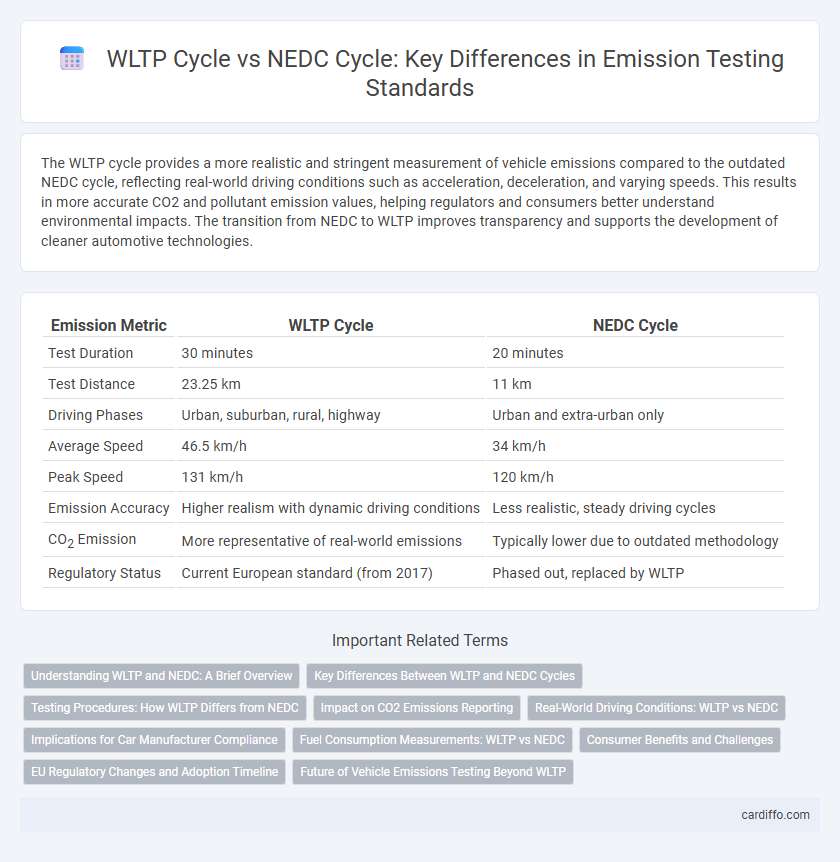The WLTP cycle provides a more realistic and stringent measurement of vehicle emissions compared to the outdated NEDC cycle, reflecting real-world driving conditions such as acceleration, deceleration, and varying speeds. This results in more accurate CO2 and pollutant emission values, helping regulators and consumers better understand environmental impacts. The transition from NEDC to WLTP improves transparency and supports the development of cleaner automotive technologies.
Table of Comparison
| Emission Metric | WLTP Cycle | NEDC Cycle |
|---|---|---|
| Test Duration | 30 minutes | 20 minutes |
| Test Distance | 23.25 km | 11 km |
| Driving Phases | Urban, suburban, rural, highway | Urban and extra-urban only |
| Average Speed | 46.5 km/h | 34 km/h |
| Peak Speed | 131 km/h | 120 km/h |
| Emission Accuracy | Higher realism with dynamic driving conditions | Less realistic, steady driving cycles |
| CO2 Emission | More representative of real-world emissions | Typically lower due to outdated methodology |
| Regulatory Status | Current European standard (from 2017) | Phased out, replaced by WLTP |
Understanding WLTP and NEDC: A Brief Overview
WLTP (Worldwide Harmonized Light Vehicles Test Procedure) provides more accurate emission and fuel consumption data by simulating real driving conditions compared to the outdated NEDC (New European Driving Cycle). The WLTP cycle includes varied speeds, acceleration patterns, and driving phases, resulting in higher and more realistic CO2 emission values. Transitioning from NEDC to WLTP improves the reliability of emissions testing for regulatory compliance and environmental impact assessments.
Key Differences Between WLTP and NEDC Cycles
The WLTP (Worldwide Harmonized Light Vehicles Test Procedure) cycle provides more accurate emission measurements by replicating real driving conditions, unlike the NEDC (New European Driving Cycle), which is based on outdated, idealized scenarios. WLTP incorporates higher speeds, dynamic acceleration, and variable temperatures, leading to more representative fuel consumption and CO2 emission data. Consequently, WLTP results typically show higher emissions compared to NEDC, reflecting stricter global regulatory standards.
Testing Procedures: How WLTP Differs from NEDC
The WLTP testing procedure incorporates more dynamic driving conditions with higher speeds, acceleration rates, and longer distances compared to the NEDC cycle, providing a more realistic representation of real-world emissions. Unlike the NEDC's simplified constant speed phases, the WLTP includes varied driving phases such as low, medium, high, and extra-high speed, which result in different emissions profiles. This shift leads to more accurate CO2 and pollutant emission measurements that better reflect actual vehicle performance on roads.
Impact on CO2 Emissions Reporting
The WLTP (Worldwide Harmonized Light Vehicles Test Procedure) cycle provides more accurate and realistic CO2 emissions data compared to the outdated NEDC (New European Driving Cycle) cycle, reflecting real-world driving conditions and higher average speeds. By incorporating factors such as variations in speed, acceleration, and driving patterns, WLTP typically reports higher CO2 emissions values, resulting in more reliable and transparent environmental impact assessments. This improved precision influences regulatory compliance, vehicle taxation, and consumer information, driving manufacturers to develop cleaner technologies.
Real-World Driving Conditions: WLTP vs NEDC
The WLTP cycle provides a more accurate representation of real-world driving conditions compared to the NEDC cycle by including varied speeds, dynamic acceleration, and diverse road types that mirror everyday usage. WLTP's measurement of emissions reflects more realistic fuel consumption and pollutant outputs, addressing the limitations of the NEDC that often underestimated emissions under actual driving scenarios. This results in stricter emission standards and improved data reliability for regulatory authorities and consumers assessing vehicle environmental impact.
Implications for Car Manufacturer Compliance
The WLTP cycle presents stricter and more realistic testing conditions than the NEDC cycle, requiring car manufacturers to meet lower emission limits under varied driving scenarios. Compliance with WLTP demands advanced engine calibration, improved after-treatment systems, and comprehensive vehicle testing to accurately reflect real-world emissions. This shift increases costs and development complexity but ensures transparency and alignment with evolving regulatory standards.
Fuel Consumption Measurements: WLTP vs NEDC
The WLTP cycle provides more accurate fuel consumption measurements than the NEDC cycle by incorporating real driving conditions, higher speeds, and dynamic accelerations that reflect real-world vehicle use. Unlike the NEDC, which underestimates fuel consumption due to its outdated, simplified testing protocols, WLTP captures a broader range of driving behaviors, resulting in higher and more realistic fuel consumption values. This shift leads to improved transparency in vehicle emissions and enables consumers to make better-informed choices based on reliable fuel efficiency data.
Consumer Benefits and Challenges
The WLTP cycle offers consumers more accurate and realistic fuel consumption and emission data compared to the outdated NEDC cycle, enabling better-informed vehicle purchasing decisions and promoting environmental awareness. However, the transition to WLTP brings challenges such as higher reported emissions and fuel consumption figures, which may confuse consumers accustomed to the lower NEDC values. Despite these challenges, WLTP fosters transparency and drives manufacturers to improve vehicle efficiency, ultimately benefiting consumers through cleaner and more efficient vehicle options.
EU Regulatory Changes and Adoption Timeline
The transition from the NEDC to the WLTP cycle in the EU reflects stricter regulatory changes aimed at providing more accurate vehicle emissions and fuel consumption data. The WLTP, adopted by the European Commission in 2017, became mandatory for all new type approvals from September 2017 and for all new registrations starting September 2018. This shift enhances the reliability of emissions testing by incorporating real driving conditions, addressing shortcomings of the outdated NEDC cycle.
Future of Vehicle Emissions Testing Beyond WLTP
The future of vehicle emissions testing will build upon the WLTP cycle by incorporating real-driving emissions (RDE) testing and integrating advanced sensor technologies to capture more accurate, real-world pollutant data. Emerging regulations emphasize the need for dynamic testing environments that reflect diverse driving conditions, pushing beyond the controlled settings of WLTP and NEDC cycles. Enhanced data analytics and connected vehicle systems are expected to revolutionize emissions monitoring, enabling continuous, real-time compliance verification and supporting stricter global emission standards.
WLTP cycle vs NEDC cycle Infographic

 cardiffo.com
cardiffo.com